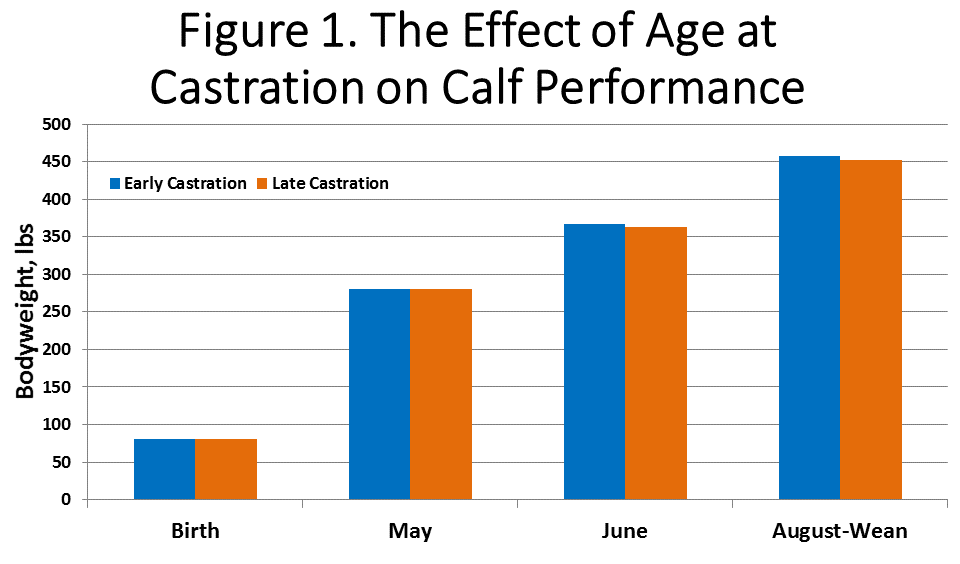
Calves born from crossbred cows in Florida (Alachua Co.) can be castrated within 36 day of birth and still have satisfactory weaning weights. Photo Credit: Matt Hersom
Dr. Matt Hersom, Extension Beef Cattle Specialist, Department of Animal Sciences, University of Florida
Castration, the process of removal or destruction of the testicles, is a common management practice within beef cattle operations. Approximately 60% of beef cow-calf producers castrated their male calves prior to sale (USDA-NAHMS, 2008).There are a number of reasons cattlemen choose to castrate calves before marketing, the primary reason is market demand and economics. Traditionally, steers have a distinct advantage in the market place over bulls because steers fit within modern beef production systems and produce a more desirable carcass for consumers. Although the practice of castration is widely utilized within the industry, the timing and method used for castration can vary considerably between operations. Factors that may impact timing of castration include producer philosophy, product marketing claims, weather, and availability of resources such as facilities or labor.
Some cattlemen believe that delayed castration improves growth in nursing calves. This belief is also endorsed by some castration tool manufacturers who claim that delayed castration creates significant weight gain advantages at weaning compared to calves that were castrated shortly after birth. Since producers are paid on a weight basis, most cattlemen opt to market their calves at weaning. Consequently, differences in weaning weight can mean differences in profitability. Most research literature suggests that castrating calves shortly after birth has minimal to no effect on weaning weight.
The issue of age at castration was examined in a Florida setting to ascertain if timing of castration resulted in significant differences in growth rate and weaning weight in nursing calves. A full description of the study can be found in this UF/IFAS publication: Effect of Age at Castration on Beef Calf Performance. Calves born in December to March were divided into two groups and castrated at different times: Early (average of 36 days of age in March/April) or Late (average of 131 days of age in June). Figure 1 shows the body weights of the calves during the demonstration. Calves had similar birth weights and by May the Early castrated calves continued to have similar body weights compared to calves that had not been castrated. This implies that calves castrated at or near birth had overcome any potential growth delays related to castration by the time body weight measurements were initiated. Additionally, Early castrates did not seem to experience any significant disadvantage in growth due to treatment during the remainder of the summer. No differences were observed in body weight change and average daily gain during the trial period. In fact weaning weights were similar between Early and Late castrated calves. Since both Early and Late castration occurred prior to weaning and the onset of puberty, these results would seem reasonable.
 The concept underlying delayed castration is to leave male calves intact long enough to capture the benefits of the calf’s own hormones that are known to stimulate growth. However, to capture the full benefit, castration would most likely need to be delayed until calves approach puberty. It is only at this point that calves would have the ability to secrete enough testosterone to create significant differences in weight and growth performance. The comparable pubertal status of the treatment groups in this study likely contributed to the similar weaning weights and growth measures between the early and late castrates.
The concept underlying delayed castration is to leave male calves intact long enough to capture the benefits of the calf’s own hormones that are known to stimulate growth. However, to capture the full benefit, castration would most likely need to be delayed until calves approach puberty. It is only at this point that calves would have the ability to secrete enough testosterone to create significant differences in weight and growth performance. The comparable pubertal status of the treatment groups in this study likely contributed to the similar weaning weights and growth measures between the early and late castrates.
Take Home Message
Calf performance results from this trial and others suggest that producers have some degree of flexibility in determining when to implement castration. Producers should recognize that castration at or shortly after birth will not have a detrimental effect on calf performance or ultimate weaning weight. Equally important, producers should also realize that delaying castration until calves are approximately 131 days old will not bring added pounds at weaning, despite a common belief to the contrary.
- Clemson Virtual Southeast Cow-Calf Conference – November 11-12 - November 6, 2020
- Dispelling Cattle Mineral Supplementation Myths - November 15, 2019
- What Influences Profit for the Beef Cattle Enterprise? - June 3, 2019
